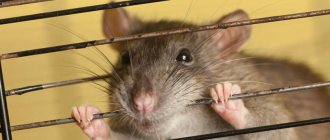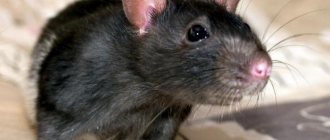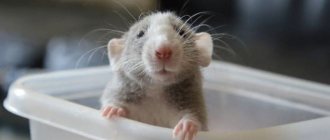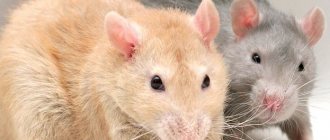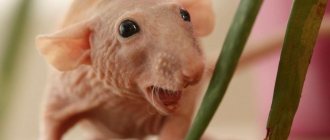Not only does a rat bite cause severe pain, it can also be dangerous. While a domestic rat that lives in a cage and receives proper care is quite safe and harmless, the same cannot be said about a wild animal. Wild rodents are carriers of serious diseases such as tetanus or rabies. Knowing what to do if bitten by a rat will help you avoid the development of dangerous diseases.
Recognizing a rodent bite
Rats bite with their front incisors. Deep damage to the skin is accompanied by severe pain, and the wound can take a very long time to heal.
What do rat bites look like:
- severe bleeding appears;
- the appearance of the wound corresponds to the location of the rodent’s incisors, with which it makes a puncture (usually several holes);
- local increase in temperature in the damaged area of the skin;
- spreading swelling and bluish color of the skin due to injury to the capillaries.
Most often, animals bite on the limbs, rarely on the face. After a bite, various signs may appear that indicate infection with dangerous diseases.
Why do rats bite?
A rat bites to protect itself or its offspring. She attacks people when they try to catch her. Utility workers are often attacked by rodents in basements. A person can provoke a rat if he waves his arms, a stick, or shows his fear by panicking.
In more rare cases, animals attack sleeping people, gnawing their heels. In impoverished areas of third world countries, rat attacks mainly target homeless people living in basements.
Before attacking, the rodent stands on its hind legs, swinging its body. At the same time, he tries to scare the person so that he can escape. The animal rushes at people from a distance, making a jump. Can bite, leaving deep wounds.
First aid to the victim
After a bite, a person needs immediate medical attention. Rats have thin incisors, so the skin punctures are quite deep.
What to do if you are bitten by a rat:
- opening the damaged area of the skin and placing an ointment with antibiotic properties (for example, Levomekol) into the wound;
- washing the wound with peroxide or treating the edges of the wound with brilliant green;
- treating the wound with a soapy solution (2/3 of a bar of soap in 3 cups of clean water);
- applying cotton wool and a clean bandage to the injured area.
If the wound is superficial, it is enough to wash it with soap and water for 2-3 minutes. To do this, pour the finished mixture into a pear and treat the damaged area under low pressure.
Timely assistance reduces the possibility of infection by 70%, and washing with antiseptics allows you to destroy bacteria and prevent pathogenic organisms from entering the rodent’s saliva into the blood of the bitten person.
Treatment for fever from a bite
In addition to a special medical serum against rat bites, the victim is prescribed injections of Penicillin, an antibiotic that is administered intramuscularly. The course of treatment is from seven to ten days. Patients who are allergic to this drug are prescribed analogues - Streptomycin or Chloramphenicol (also in the form of injections). If the wound is very serious, the doctor increases the dosage of injections to four weeks.
For prevention, in order to avoid negative consequences and complications, the patient takes the drug Tetracycline four times a day for the first five days after a rat bite.
What diseases does a rat carry?
First of all, what is dangerous about rat bites is the risk of contracting unpleasant diseases carried by rodents. Their consequences for the human body vary from mild to extremely severe. Today, more than 25 diseases are known that develop from a rat bite.
Leptospirosis
This is an acute infectious disease, the main causative agent of which is bacteria of the Leptospira group. The disease causes damage to the liver, kidneys and central nervous system, as well as jaundice and hemorrhagic syndrome. Death occurs in 15% of cases.
Signs of leptospirosis infection from the bite of a wild or domestic rat:
- constant weakness;
- yellow whites of eyes;
- temperature increase to 40C;
- chills;
- headaches;
- apathy;
- sleep disturbance;
- severe pain in the calf muscles;
- increase in liver size.
Coxiellosis
An infectious focal disease that affects the lungs.
The main features are:
- pain in the lumbar region;
- headaches;
- cough without sputum production;
- muscle pain;
- weakness;
- increased sweating;
- decreased appetite;
- insomnia.
Yersiniosis
Acute infectious disease. Affects the gastrointestinal tract, skin and causes severe intoxication. Taking into account the development, the pathology affects the kidneys and the musculoskeletal system. The incubation period is up to 20 days.
The main signs of yersiniosis:
- chills;
- rash;
- temperature increase to 40C;
- feeling of nausea;
- headaches;
- pain in muscles and joints;
- diarrhea;
- stomach ache.
Tetanus
One of the most severe consequences of a rat bite is tetanus, an acute infectious disease that affects the nervous system and is accompanied by generalized convulsions due to tension in the skeletal muscles. The danger is that the time from the bite to the appearance of the first symptoms of the disease can reach 1 month.
Signs of the disease:
- nagging pain in the bite area;
- facial muscle spasms;
- difficulty swallowing;
- tension in the muscles of the neck, limbs, abdomen and back;
- breathing disorder.
All symptoms are accompanied by severe pain. Unfortunately, all of the above phenomena usually lead to death.
All wounds, even the most minor scratches, and even more so animal bites, must not be ignored. But the most effective method to protect yourself from this disease is timely preventive vaccinations. This is a case where it is easier to prevent than to cure.
But it is almost impossible to get rabies after a rat attack. They say that only a few such cases are known, and even in those there are doubts whether this particular rodent was to blame.
Features of rat behavior
Rats are small animals with their own behavioral characteristics. Knowing them, you can minimize the risk of unwanted contact.
Reasons for attacks on people
This rodent, despite its close proximity to humans, prefers to avoid meeting him. An attack is possible if he feels hungry for a long time, but has nothing to eat. At risk are children, paralyzed patients, and adults who are heavily intoxicated by alcohol or drugs.
Note! A rat loses its sense of fear if it becomes infected with any viral disease. They become aggressive and stop hiding.
There are frequent cases of attack by an animal driven into a corner. Do not insist on playing with your pet if it has already refused once. Otherwise, the bite cannot be avoided. There are even known cases of rat bites in pet stores - they are under constant stress.
An adult female may show aggression if she sees that her offspring are in danger or the nest has been broken.
When rats bite
This animal rarely attacks first. But if, while next to him, you wave your arms or a stick, stomp, or perform other sudden actions, then he will take an attack pose. It looks like this:
- she stands on her hind legs;
- the body sways from side to side;
- a loud squeak is made, followed by an attack.
How a rat bites
The teeth of this rodent are quite long. They constantly sharpen them on all objects that come their way. In action are:
- crackers and other food products;
- paper;
- tree;
- plastic;
- concrete and other building materials.
Human skin is very thin, it is quite easy to bite through it. The greatest danger is posed by the lower incisors - they are sharp and long. More often they bite fingers, arms, and legs. A rat bite looks like puncture wounds that bleed.
Differences between rat bites and bites of other animals
Sometimes it can be difficult to distinguish a rat bite from another animal bite. The injury can occur while sleeping or on the street. Particularly difficult is an injury sustained by a child or animal.
In this case, you need to carefully examine the affected area. If you can see marks from the upper and lower incisors close to each other, then this is often evidence of a rodent bite.
It doesn’t really matter whether it was a mouse, a vole, or a hamster. They are all equally dangerous to humans.
When is urgent medical attention needed?
If you are bitten by a rat, you should immediately go to the hospital if, 2-3 days after the incident, a person experiences the following symptoms:
- headaches;
- significant increase in temperature;
- nausea and vomiting;
- diarrhea;
- chills;
- muscle pain;
- constant weakness;
- skin spasms around the injury;
- increase in liver size.
These symptoms indicate infection with a viral disease and require urgent medical attention.
How to Avoid Bites
To avoid becoming a victim of a rat, first of all you need to avoid places where they live - landfills, basements of residential buildings, abandoned houses.
If you do happen to encounter a rat, under no circumstances should you panic, try to run away, or attack the animal (especially if you have a female in front of you, protecting her offspring).
Try to back away as slowly and carefully as possible to demonstrate to the rodent that you will not cause harm. Rats have a pronounced instinct of self-preservation.
Rats are harmful rodents that cause damage to furniture and people's food. They often settle near human habitation in order to easily obtain food for themselves.
As a result, there are frequent cases of rat attacks on humans. Under no circumstances should you provoke a rat to lunge, but if a bite occurs, be sure to provide first aid to the victim as soon as possible and take him to the emergency room. These actions are required if suspicious symptoms appear during the first few days - headache, nausea, weakness, chills, etc.
Are bites from tame rodents dangerous?
Rodents purchased from a pet store are safe. Rats are carriers of diseases only if they are bitten by an infected animal. The possibility of getting sick is minimized, but still present.
If a decorative rat inflicts a superficial injury during a bite, just wash the wound with soap and treat it with brilliant green.
If an animal bites until it bleeds, the injured area may fester. To prevent infection, the wound is washed with soapy water and then treated with Rivanol.
Rodent control products
There are many repellent devices, and the operating principle is based on ultrasonic and electromagnetic waves. Such devices do not kill rodents, but force them to leave the room by affecting the nervous system. What types of repellers exist and what are the differences in operation:
- Electronic repellers. The essence of these devices is to distribute magnetic pulses through an electrical wire, which is a powerful irritant for rats and mice. The range of these repellers is enough to cover the entire area of the room.
- Ultrasonic repellers. These devices act on the nervous system of rodents with high-frequency sound vibrations with changing frequencies, due to which the rats do not have time to get used to the ultrasound and quickly flee.
- Combined repellers. These devices combine a dual effect on pests: high frequency sound and low range of electromagnetic waves. This variable component does not allow rodents to adapt.
The choice of a specific repellent device depends on a number of factors: the number of rats and mice, the area of residence, the level of human comfort, etc. Each device has a different radius of influence, so choosing a repeller for a specific case will not be difficult. Their undoubted advantage is that they quickly drive rodents out of the house.
Rat bite in a child
The most common situation is when a rat bites a child’s finger, protecting little rats; at this time the rodents become very aggressive.
The wound itself must be treated and disinfected. After this, you need to monitor the child’s condition for 2-3 days. If a rat bites your finger, there are usually no serious consequences; sometimes the temperature increases. In this case, you need to call a doctor and, if necessary, get the appropriate vaccinations. After the interview, the doctor will decide what to do next: treatment at home or hospitalization of the child.
If bitten by a home decoration
If you are bitten by a domestic rat, it is imperative to disinfect the wound. Even if the pet is tame, you still cannot exclude the possibility of an infection getting into the wound, even if it is not life-threatening. More often, a bite from a domestic rat is accompanied by slight swelling and redness of the skin; in very rare cases, an increase in temperature is possible.
Decorative tame rats bite only in exceptional cases, for example: if the female is pregnant (she becomes more aggressive), or if you want to pet the babies, she will feel threatened and bite. In most cases, bites do not leave negative consequences.
Rat bite on a pet
Adult pets most often do not require immediate help after a rat bite. Cats and dogs lick wounds on their own, and their saliva is much more effective than any antiseptic. Usually, a bite is not dangerous for a pet if it can lick the damaged skin itself.
The wound should be treated in puppies or kittens that do not yet know how to lick themselves. Animals require urgent care, the same as for people. The damaged skin is washed, treated with an antiseptic, and the wound is bandaged.
The same measures are carried out if a rodent has bitten an animal on the ear, neck, or nose - in this case, the pet will not be able to completely lick the wound on its own.
If symptoms of disease development are observed, you should urgently call a veterinarian. Especially if the animal begins to have muscle cramps on the back, coordination of movement is impaired, and the pet cannot fully chew food. This is how tetanus manifests itself. You should not decide for yourself what to do if a rat has bitten a pet, and choose medications at your own discretion.
Brief description of rat species
Probably everyone knows what wild rats look like. Even if you have never met a rat in person, you know exactly what it looks like. All thanks to popular culture and cinema.
There are three species of rats in Russia and the CIS countries. All of them, one way or another, pose a danger to humans . And we are talking not only about dangerous diseases that a person can become infected with after a rat bite, but also about damage to agriculture, food supplies in the house and even furniture. The larger the colony of rats, the more trouble it can cause.
Gray rat (pasyuk)
The gray rat is the most common. And in size it is clearly larger than its counterparts. It is difficult to judge what size rats are. A well-fed rat with direct and constant access to a food source can gain up to 1-1.5 kg. But most gray rats do not weigh more than 0.3-0.5 kg.
What does a rat look like compared to mice?
The gray rodent has 16 teeth, 12 of which are molars, and 4 are impressively sized incisors. It is with the incisors that the rat bites.
Pasyuk is omnivorous . It hunts small mammals and skillfully and cruelly destroys bird nests. He also loves the succulent parts of various plants, young bark, all types of grains, any food in the house and, of course, your furniture. Sometimes it can hunt cats and dogs, especially in a pack . Swims great, dives great.
Interesting! Although the gray rat can climb, it prefers to walk on hard surfaces and find food there. But if the rodent is hungry, it will easily climb onto a high shelf or into a cabinet in the kitchen.
The animal is distinguished by its cruelty and impudence. It can attack a person, but only in cases where there is no other choice. There are known cases when a pack of rats attacked cattle and pigs.
Black wild rat
Photo of a black wild rat
Black rats differ from their gray counterparts in having a more moderate temperament, size and agility. They are not so aggressive and lead a hidden lifestyle . Adults rarely weigh more than 0.3 kg.
This rodent also likes to settle closer to humans and food. Loves warmth and usually does not dig holes. It settles in tree hollows, under the floor in a private house or apartment, making a nest, like a bird.
It does not reproduce as actively as the gray rat, so these two species never live next to each other. Moreover, gray rats often hunt their smaller black-colored brothers.
Can't swim and runs away at the first sign of danger. Does not attack dogs and cats. Black rats are extremely careful. They are not predators , preferring to feed on roots, grains, nuts and fresh shoots of various plants. They live in large flocks, where the leader rat is the main one.
Interesting fact! Previously, black rats lived in thatched roofs, which is why they were called roof rats.
Turkestan rat
Photo of Turkestan rat
The Turkestan rat is more like a house mouse. This is a cross between a black and gray rat. The size of an adult is no more than 0.3 kg. The character is not aggressive. On the contrary, at the slightest danger the rodent flees.
It prefers to live in the wild, but with the onset of cold weather, or when there is not enough food for life and reproduction, it comes closer to people. The Turkestan rat can be found both in a private house and in an apartment on the 9th floor .
The rat is especially troublesome for farmers and agricultural land. The rodent feeds on various grains, green shoots, young bark and nuts. Attempts to destroy the species are made annually, but this only temporarily restrains the growth of the colony.
Prevention and precautions
To prevent rat bites, you must take the following precautions:
- it is forbidden to touch rats (even dead ones brought by cats);
- Do not visit rodent habitats (basements, underground sewers, cellars, landfills, construction sites);
- Be careful near fields and ponds;
- You should not pet an aggressive pet rat. A rodent can be calmed by splashing cold water on the animal;
- a pet rat requires vaccination and regular veterinary examination;
- If you cannot avoid meeting a rat, you should not provoke it to attack (try to make contact, drive it into a corner, move sharply).
A rat bite is a serious reason to seek medical attention. But even a professional doctor will not be able to help a person if treatment is delayed. Therefore, you definitely need to know what to do when attacked by rodents and how to provide first aid.
What to do if rats bite children in kindergarten?
In many cases, rat bites require not only therapeutic but also administrative measures. Still, in accordance with sanitary standards, there should be no rats, mice, or any other rodents in the premises next to a person. And if in his home a person himself is responsible for preventing their occurrence, then in various educational institutions it is quite possible to demand compliance with these measures from the administration.
For example, if rats bite children in a kindergarten, there is a flagrant violation of sanitary standards. What should be done if the kindergarten administration did nothing in response to such an emergency?
- Compile and send an application to the regional SES office. The service usually responds promptly to complaints regarding municipal enterprises;
- Send an appeal to the deputy head of the city administration;
- If there is no response from the deputy head and the SES, write a complaint to Rospotrebnadzor.
It is very important that all complaints and appeals be collective, from at least three to four parents. This will help employees of the relevant services to distinguish the real problem from the far-fetched complaints of some scandalous mother.
It is advisable to attach to all requests copies of certificates from the clinic where the bitten children were examined by a doctor, as well as photographs and copies of letters to other authorities from which no response was received.
Rabies in rats
Rabies, rabies, hydrophobia or hydrophobia is a deadly infection in wild animals (including rats), which is caused by the Rabies virus. It is transmitted through the saliva of an infected animal.
The pathogen spreads along the nerve pathways to the salivary glands and brain. It causes severe disorders (inflammation of the brain - encephalitis), and over time leads to death.
According to statistics, in 80% of cases, rabies is carried by wild or street animals. Rabies in decorative rats occurs after contact with them. Such cases are rare, since the pet sits in a cage most of the time and does not leave the home. If a domestic rodent escapes from home, it can become infected with hydrophobia from street animals.
This is also possible if the latter enter the home. More often, the pet is infected by the owner himself after contact with an infected animal.
Rabies virus is transmitted to decorative rats in the following ways:
- Through the saliva of a sick animal, which gets into the wound after a bite.
- Through saliva and blood that enters the mucous membranes.
- After contact with the skin of the owner who touched the carrier of the infection.
If the site of virus penetration is close to the ganglia (large nerve trunks), then the infection develops faster, the latent (incubation) period is shortened, and the clinical picture is more pronounced.
To understand whether rats have rabies, you need to know how it manifests itself. It is known that the disease occurs in 3 stages:
- The early period lasts 1–3 days. The body temperature of an ornamental rodent rises to 37.3°C. He looks depressed, lethargic, sleeps poorly, and tries to find a dark corner during the day. He has difficulty swallowing food and sometimes vomits.
- The period of aggression lasts 1–4 days. In rats, sensitivity to bright light and different sounds increases, and salivation increases. The noise may cause limb cramps. The pet becomes hyperactive, attacks people and surrounding objects (cage bars, furniture, toys). He suffers from hydrophobia and hallucinations.
- The paralysis stage lasts 1 day. The decorative rat becomes apathetic again. She experiences paralysis of her hind legs, zygomatic (jaw drops) and eye muscles. A perverted appetite appears, then she tries to eat inedible things. As a result, the animal falls into a coma and dies from paralysis of the respiratory muscles.
The latent period lasts from 14 days to 12 weeks. Rabies itself takes 10–14 days.
To understand whether a decorative rat has rabies, you need to be attentive to the health of your pet. If suspicious symptoms occur, you should immediately contact a veterinarian.
Important! The only effective way to prevent rabies is vaccination. It is recommended that pets be vaccinated against infection annually. The immunobiological drug will protect against rabies only in the first stage.
When Rabies virus reaches large nerve ganglia and enters the brain, it is no longer possible to stop the development of the infection. Then palliative (supportive) treatment is carried out using sedatives, drugs that eliminate convulsions and respiratory spasms. This allows you to alleviate the condition of the sick rat. But in most cases, the decorative rodent is euthanized, since its death is inevitable.
To prevent rabies, you need to prevent your pet from coming into contact with street and neighborhood animals. Moreover, decorative rats are more susceptible to Rabies virus than other mammals, and therefore die faster as a result of infection.
What to do if you are bitten by a wild rat
The greatest danger to humans comes from the bite of a wild animal. Let's figure out what to do if you are attacked by a wild rat.
You absolutely need to see a doctor, and before that, start treating the wound yourself as quickly as possible. Wash the affected area generously and thoroughly with a solution of laundry soap after the bleeding has stopped. To prepare the solution, take 1/3 of a bar of soap and dilute it in two glasses of water. After this, it is necessary to disinfect the wound with any antiseptic and apply a bandage. This way you will protect yourself from infection.
You can learn how to humanely kill a parasite in this article.
A wild rat, unlike a domestic rat, lives on the street, climbs into garbage cans and landfills, so the likelihood of infection is very high.
The most dangerous pests are for a sleeping person. After all, the likelihood of infection increases due to bites in the neck and face due to the peculiarities of the circulatory system in these places. The vessels here are located close to the skin, so the infection immediately enters the blood. In this case (as in others), it is also necessary to see a specialist.
